On Tuesday, the day before Spain were set to face Slovakia in the ultimate game of Group E, Luis Enrique had some interesting words to say about his side who have massively struggled to score despite some decent performances.
“I’m 100 percent convinced, and I have the sensation that we are like a bottle of champagne about to be uncorked,” the Spanish manager said about his thoughts on his side’s prospects of reaching the knockout stages of the European Championship.
The former Barcelona and AS Roma head coach was absolutely correct in his estimation of how La Roja would play against Slovakia as they eased to a 5-0 victory at the Estadio de la Cartuja and grabbed second place in the group behind a valiant Sweden.
Slovakia has now bowed out with the hefty defeat, and almost everything went wrong for them, which will be analysed in this piece.
This article will be a tactical analysis of the game between Spain and Slovakia from Wednesday afternoon. It will be an analysis of the tactics of both sides as well as a look at where the game was won and lost.
Lineups and formations
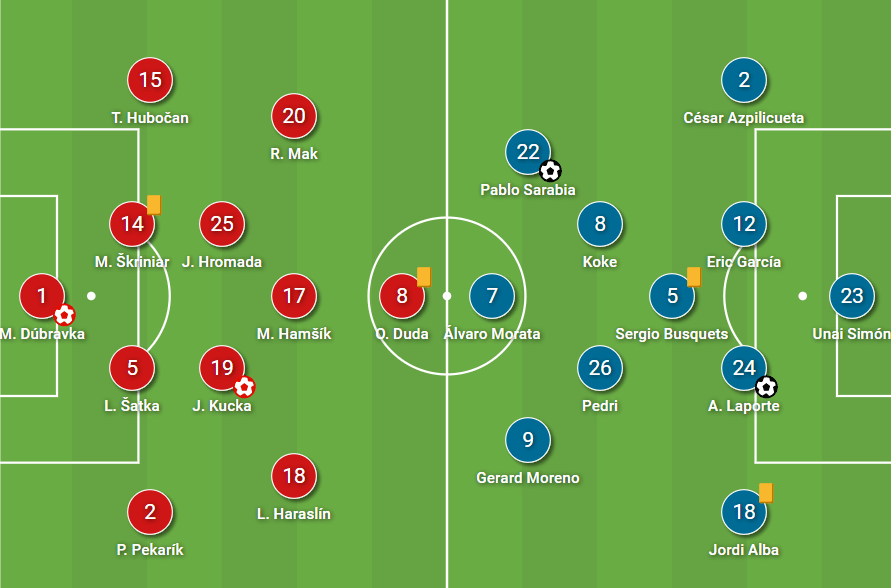
Štefan Tarkovič made a couple of changes to the Slovakia team that lost against Sweden last week in their second group game. The Slovakian maintained the 4-2-3-1 formation that has been used in every game so far but tweaked the personnel slightly.
Newcastle United goalkeeper Martin Dúbravka remained in goal and was protected by a back four of Tomáš Hubočan, Milan Skriniar, Ľubomír Šatka, and Peter Pekarík. The double-pivot ahead of the backline comprised of Juraj Kucka and Jakub Hromada, although Napoli’s Stanislav Lobotka came on at half-time.
Marek Hamšík was used in his regular number 10 position, flanked by Róbert Mak on the left and Lukáš Haraslín on the right, whilst Ondrej Duda was deployed as the lone centre-forward.
Enrique needed to react to two poor results in the opening two matches of the groups and so made several changes to the starting eleven that played against Poland last Saturday, changes that worked wonders for Spain. The formation remained as a 4-3-3, but like Tarkovič, the Spanish manager tweaked his starting eleven.
Unai Simon started once more in goal. The back four in front of him was greatly overhauled. Jordi Alba and Aymeric Laporte kept their place in the starting lineup but Pau Torres and Marcos Llorente dropped out in place of Eric Garcia and Cesar Azpilicueta.
Sergio Busquets came back into the side over Rodri and played a blinder in a midfield supported by Pedri and Koke. Gerard Moreno and Alvaro Morata stayed in the side, but Dani Olmo dropped to the bench in place of Pablo Sarabia.
Slovakia’s first line fails miserably
Itis quite easy to analyse the final defensive mistake in football before a goal or a chance occurs and pin blame on the individual. However, more often than not, the opportunity has arisen from a structural problem further up the pitch.
Slovakia’s base formation was a 4-2-3-1 but when they defended in a low block, which they did for the majority of the game, their shape was a 4-4-2 with both Hamšík and Duda acting as the first line of pressure against the Spanish defence.
The pair were tasked with putting pressure on Spain’s central defenders when they had the ball, but always ensuring that Busquets was being marked to prevent any ball progression into him because of how good he is on the ball.
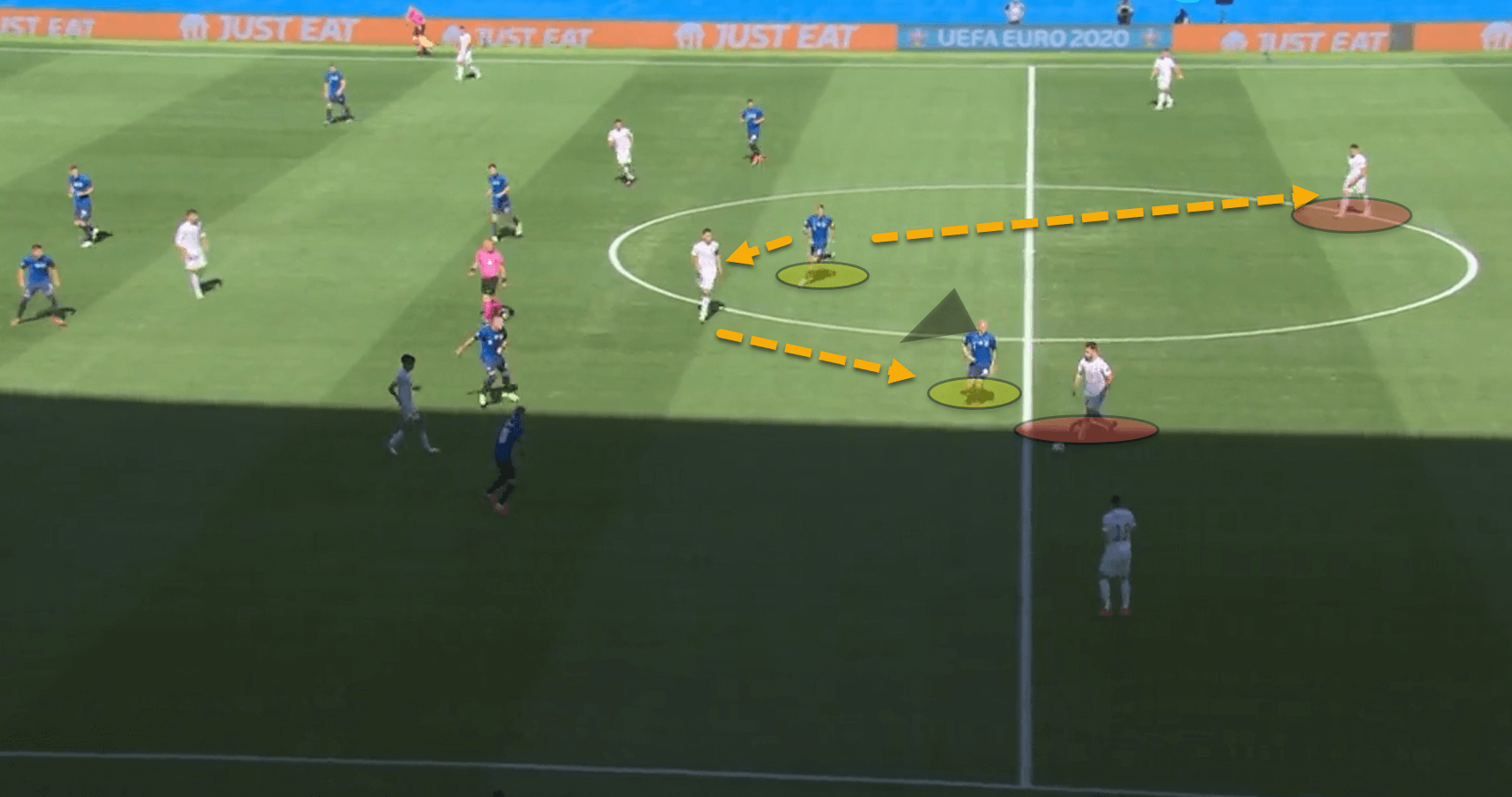
The first line of pressure must stagger when this happens, as can be seen from the image above. Duda has pushed up to press Skriniar whilst the centre-back is in possession but the forward has angled his run to ensure that a cover shadow is applied to Busquets, cutting off the passing lane into him.
If the ball was switched to the right centre-back, Hamšík would stop marking Busquets and push up to press him, angling his run to apply a cover shadow whilst Duda would drop off onto the Barcelona man.
However, this requires a lot of coordination and both players in the first line of pressure need to do this in tandem with each other. Slovakia did not do that. Far too many times Spain could play from the centre-backs straight through to Busquets as Duda and Hamšík did not cover him well enough.
The reason they found it easy was because Azpilicueta tended to remain as part of a back three alongside the two other central defenders, which meant the Slovakian first line of pressure had to deal with four players, including Busquets. It was essentially 4v2.
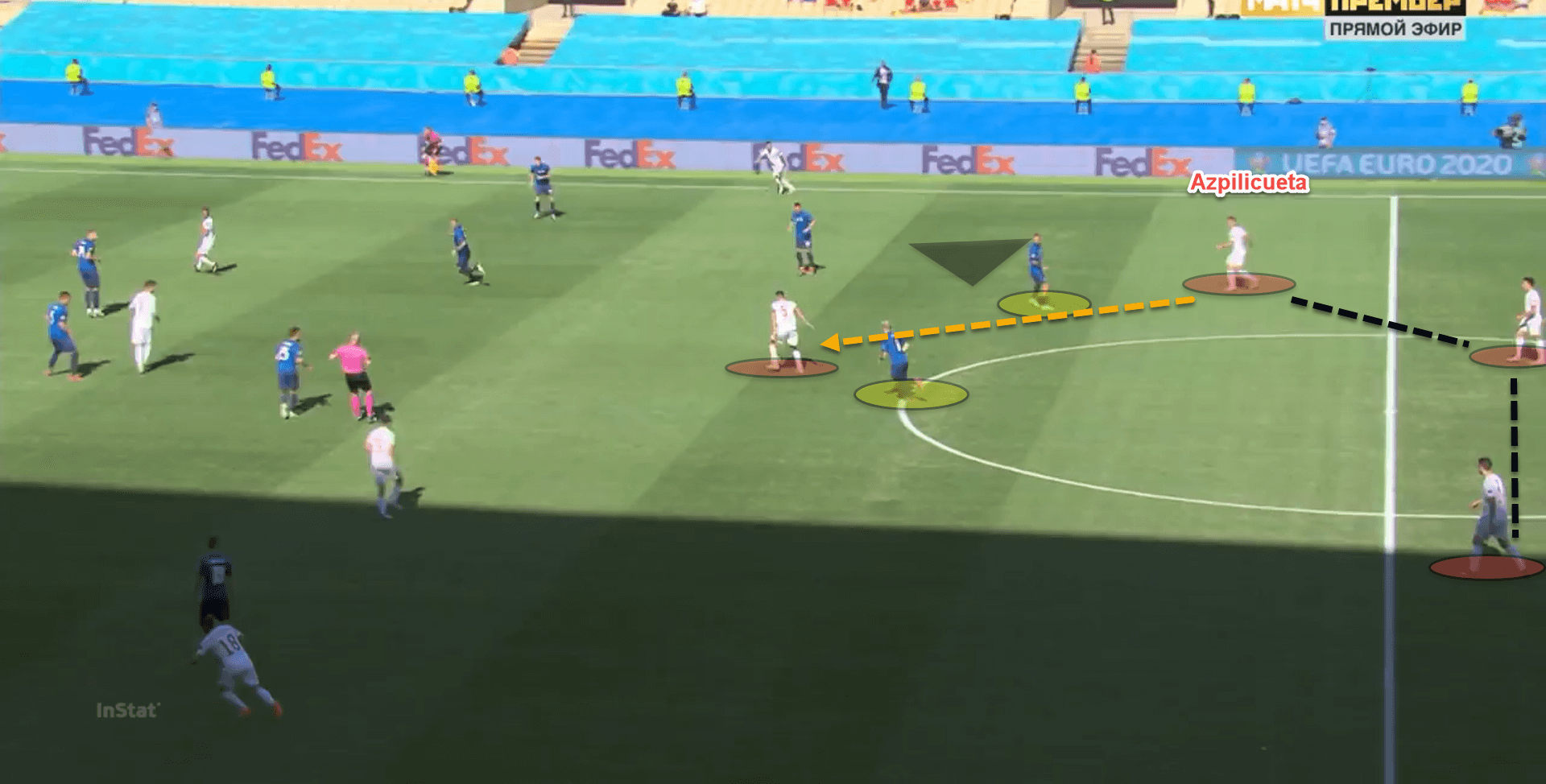
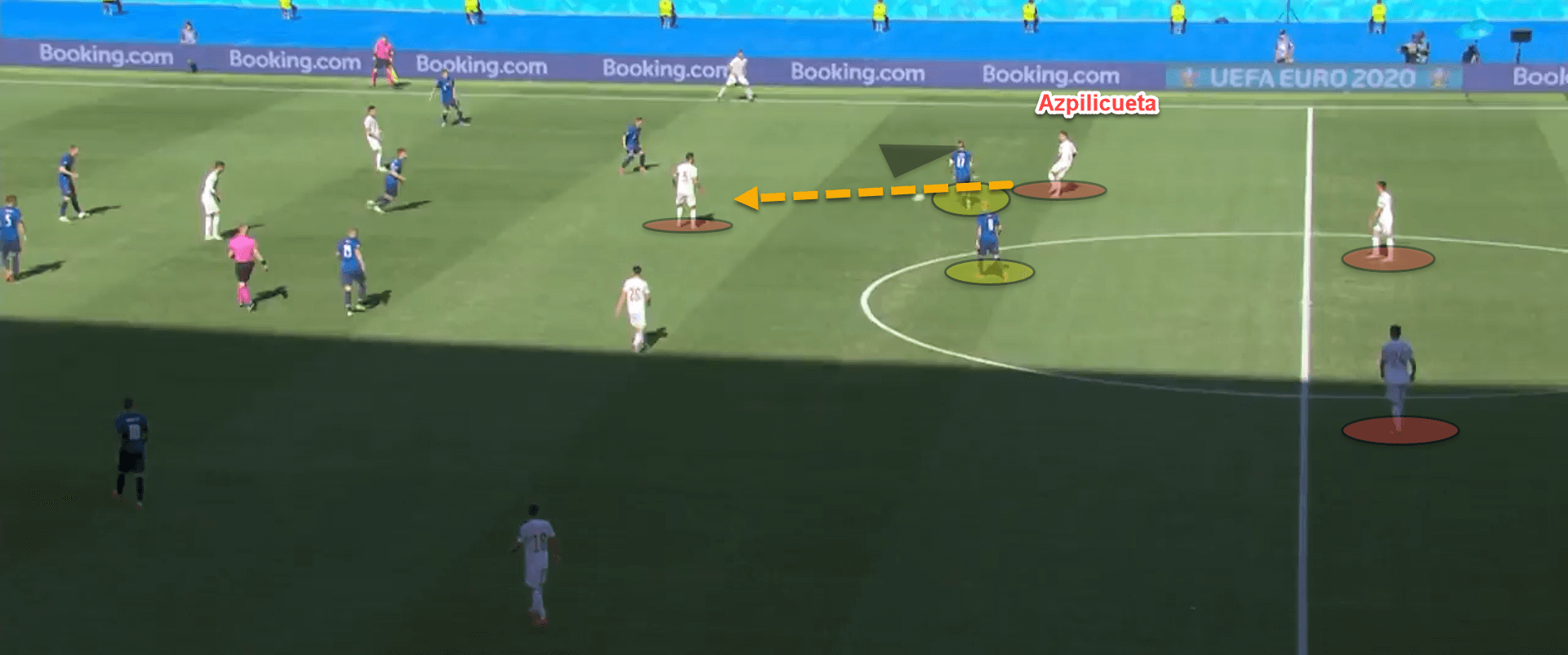
In both situations, Slovakia failed to deal with having Azpilicueta back and this allowed for easy progression through to Busquets, which became incredibly dangerous for Tarkovič’s men.
Busquets dictated the play
Busquets dominated the game and was allowed to dictate the tempo in plenty of space. As can be seen from both these images too, the Slovakian midfielders had dropped off to deal with the players in between the lines and so when the ball was progressed into Busquets’ feet, they were not close enough to close him down which gave the Spaniard an obscene amount of space to turn on the ball and pick a forward pass.
The 32-year-old sat in front of Slovakia’s midfield line for the entire game and sprayed passes from right to left, even breaking the second line on numerous occasions to put his side from the progression phase into the creation phase.
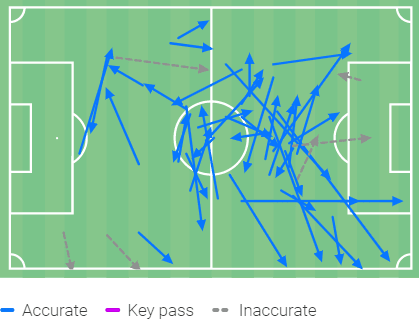
Looking at Busquets’ pass map, it can be seen how the midfielder dominated the midfield. Spain finished the game with 68 percent of the ball possession and the Barcelona star had an 88 percent passing accuracy.
The majority of his passes were to the wide areas, where Spain like to attack. His constant shifting of the ball from left to right is very useful for Enrique’s team because it helps to move the opposition and find gaps in their defensive block, and Busquets certainly found gaps in Slovakia’s low block.
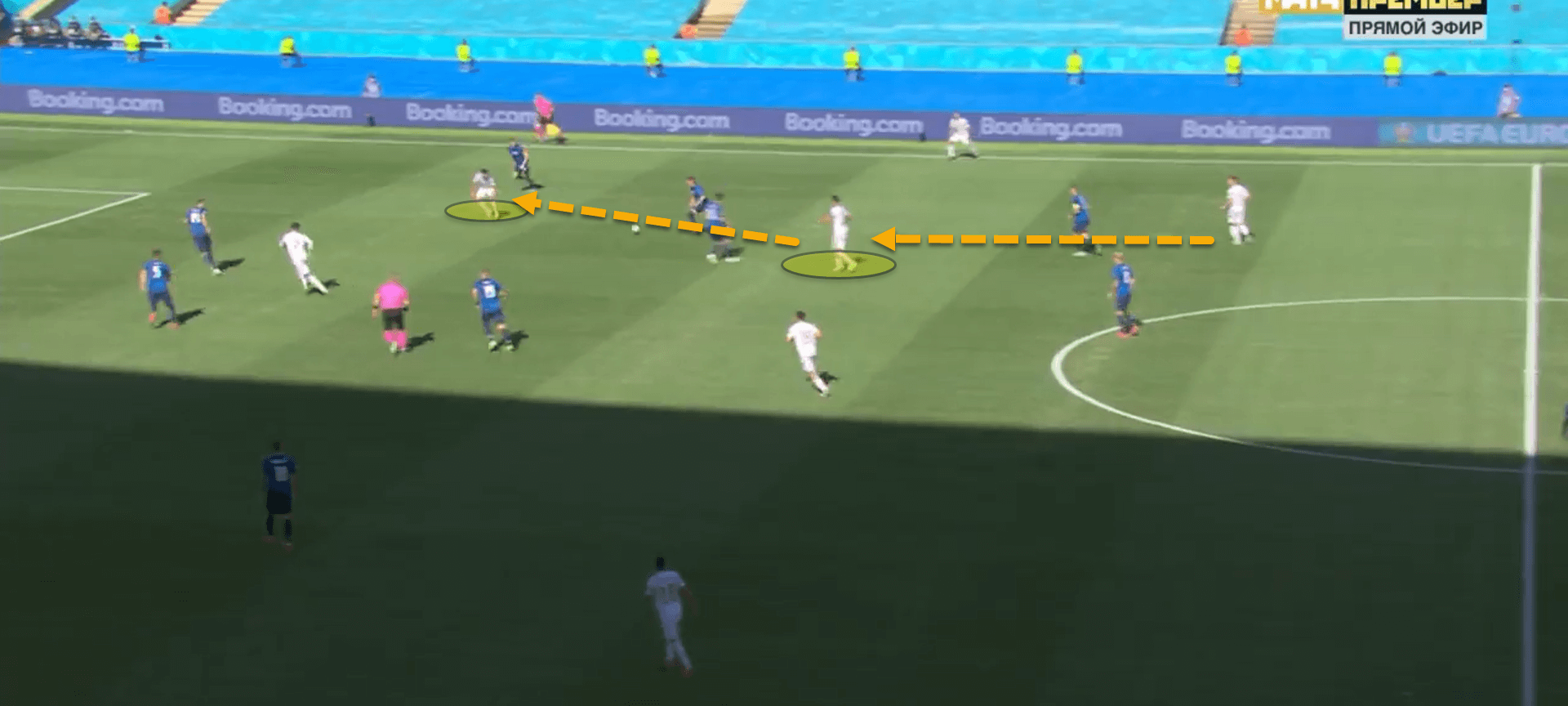
In this instance, Busquets created a great angle to receive the ball behind the Slovakian first line of pressure and instantly played a split pass through to Sarabia between the lines, bringing Spain into the final third with one pass.
The Spaniard finished the game with 2 key passes and no player managed to play more on the entire pitch, an incredible feat for a deep-lying playmaker.
To stifle Spain’s attacking play, Slovakia needed to ensure that they nullified the pivot, particularly one as good as Busquets. However, Tarkovič’s side failed to do this, Busquets took the game by the scruff of the neck, and Slovakia ultimately paid the price.
Quality in the wide areas, countermovements, and a lack of basic defending
Something that has been touched on throughout this article so far is that Spain use a lot of different variations in the wide areas to break down an opposition low block.
Against Slovakia, this was no different. According to Wyscout, Enrique’s men had 43 positional attacks throughout Wednesday afternoon’s game. 33 of these attacks were in the wide areas.
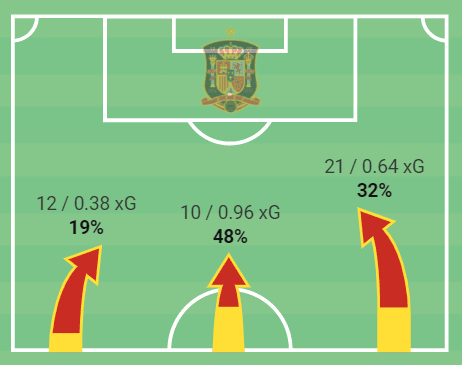
Being efficient in the flanks when attacking is a necessity for a team that dominate possession like Spain do. When defending in a low block, the team out of possession will always force the in-possession team wide and so they need to be good at breaking teams down in these areas.
As expected, Slovakia did force Spain wide, but Spain killed them out in these areas.
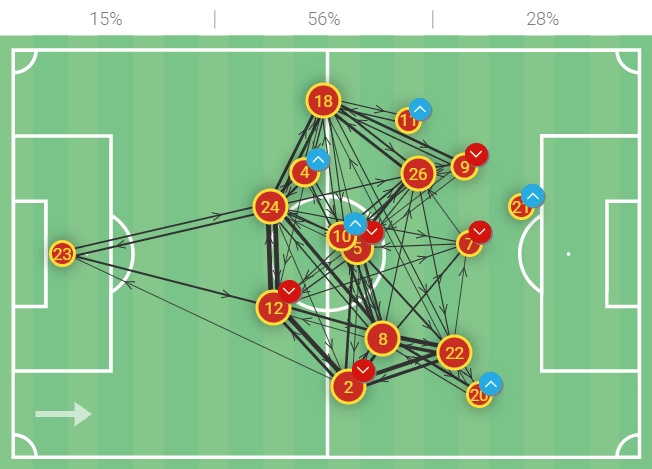
Looking at the pass map from Wednesday’s bout, Spain were very possession-heavy out on the right with Azpilicueta, Koke, and Sarabia. Sarabia and Koke rotated constantly due to their skill sets.
Sometimes Koke would drop out to the flank and act as an auxiliary right-winger whilst Sarabia inverted and positioned himself between the lines and in the halfspace. More often than not, it would be Koke in the halfspace and Sarabia holding the width out wide.
On the left side, they used the same patterns with Pedri and Moreno to break down Slovakia’s low defensive block.
One of the main patterns they used was the ball out wide to the player holding the width. This would attract the Slovakia fullback out to press and allow for the player in the halfspace to make a run on the defender’s blindside in behind.
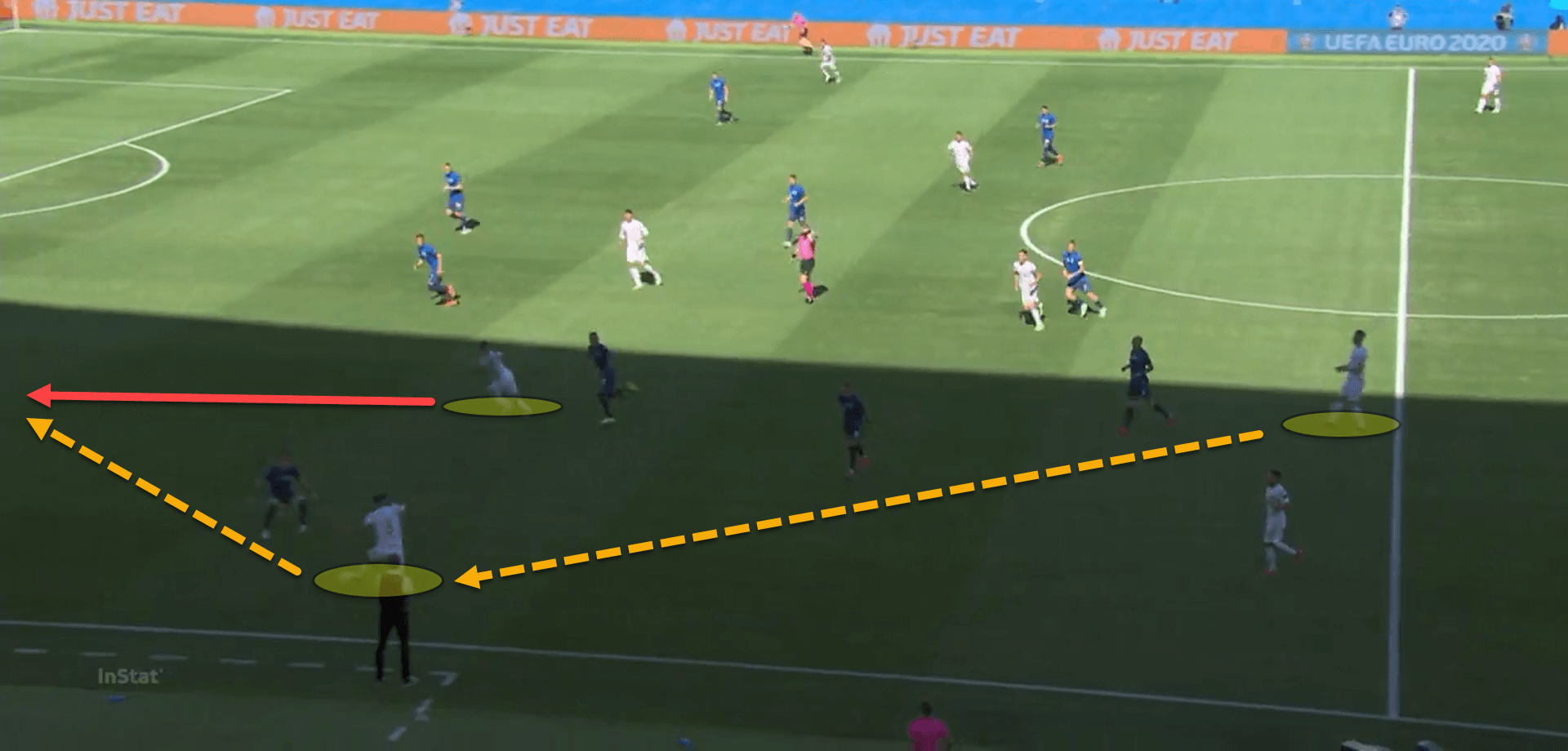
This type of pattern seems simple but with the quality and intelligence that the Spanish players have, they broke down Slovakia easily. Tarkovič’s side failed to track runners, cut passing lanes, and close down players on the ball with any conviction, and ultimately Spain rang rings around them, or play rings around them to tweak the saying slightly.
In truth, throughout the entire game, Slovakia massively struggled at a lot of basic defending principles. Spain made an incredible number of intelligent runs on the blindside of Slovakia’s players when they were defending, and these put La Roja into some incredibly dangerous positions.
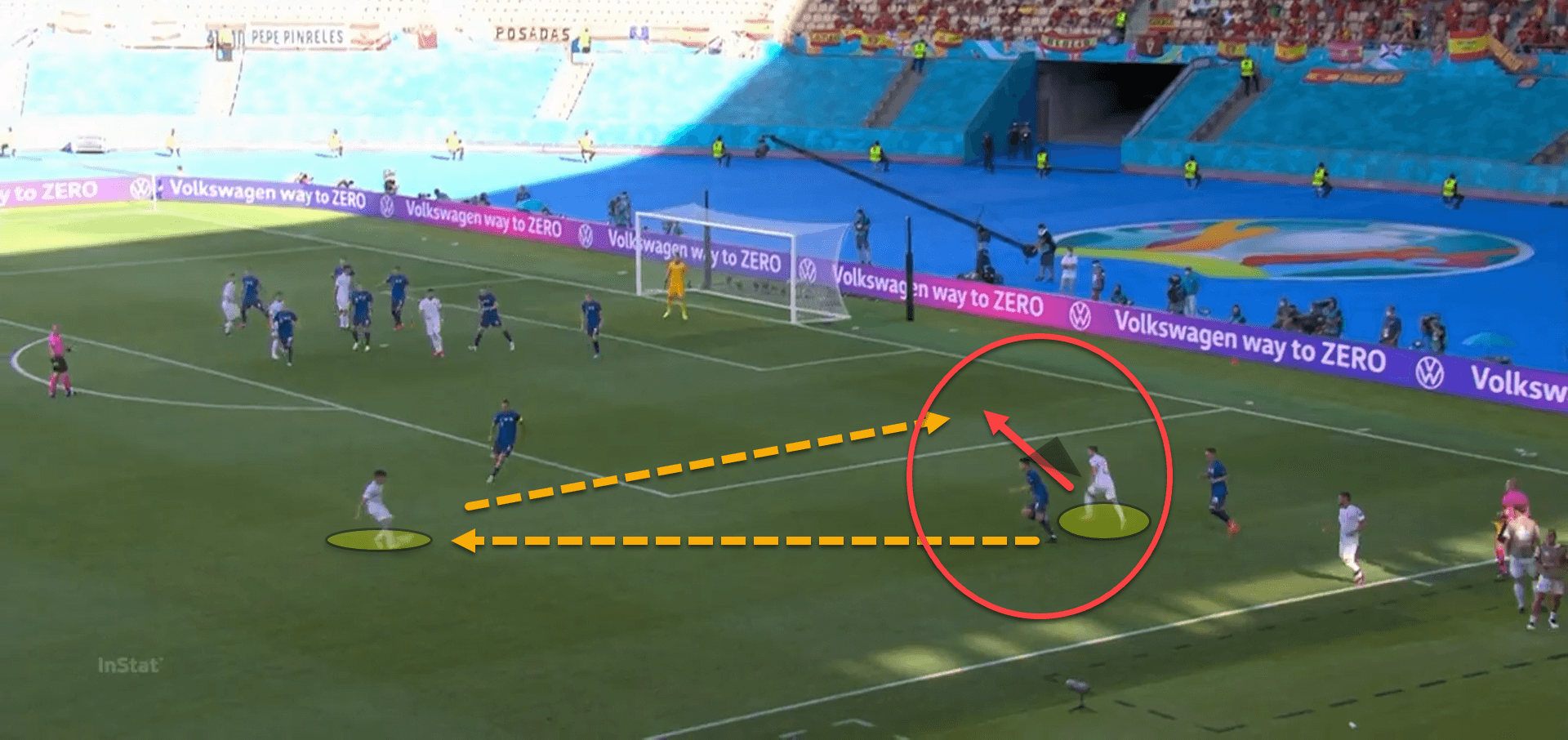
Spain are so adept at countermovements too. Countermovements are essentially two or more movements from players going in the opposite direction to each other, so if one player attacks the depth, the other drops short. Spain used these countermovements to progress the ball with ease. Morata in particular has a great reading of his teammates’ positioning, one of the main reasons he starts for Enrique’s side.
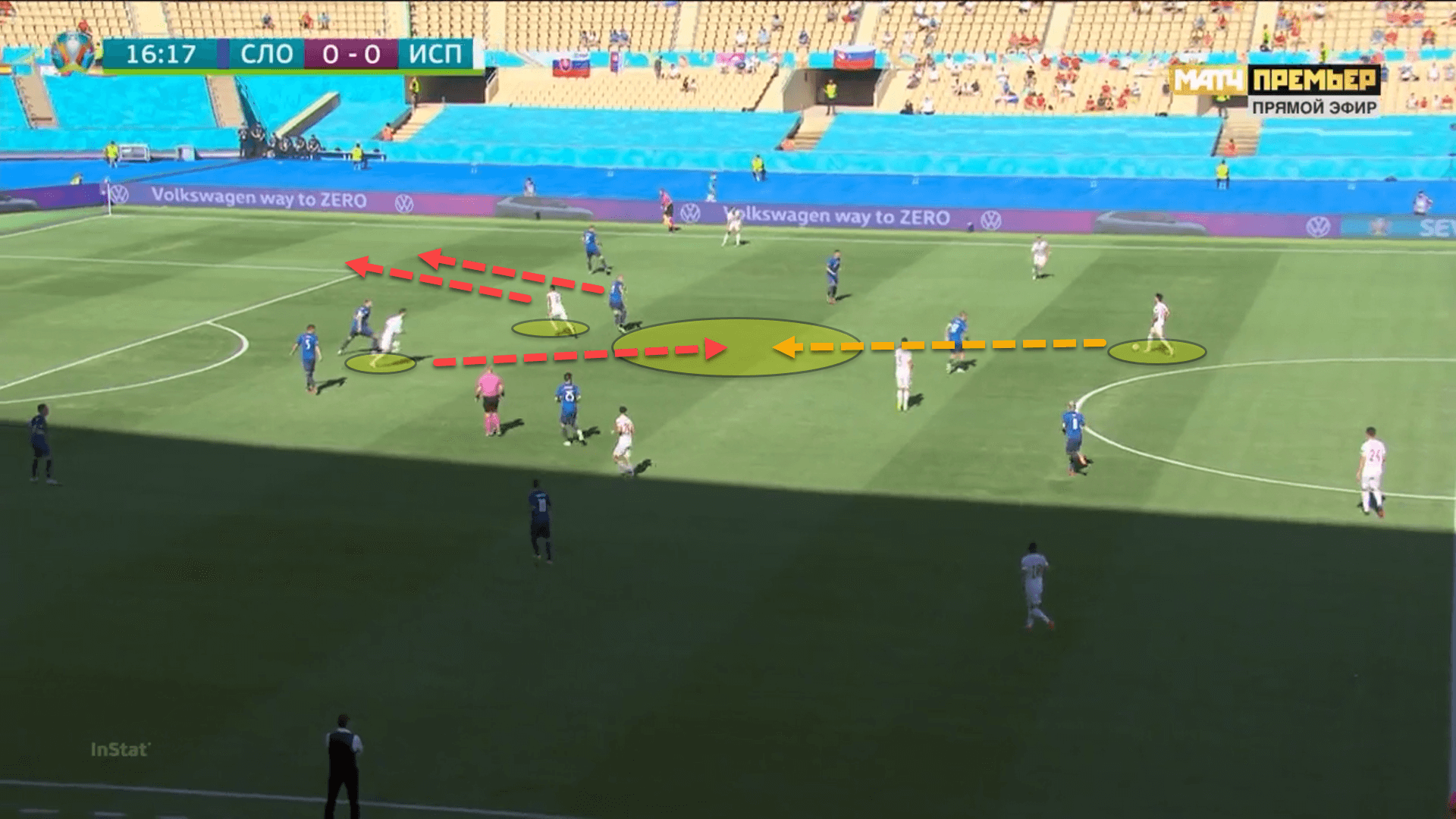
Here is an example of a brilliant countermovement by Spain. Koke attacked the channel between Skriniar and Hubočan and forced Kucka to track him, dragging him out of the midfield area and leaving space for another player to drop into.
Morata sees Koke making the run and instantly drops into the vacated space to receive the ball to feet from Garcia, allowing for an easy progression into the final third. Morata is fairly criticised for his lack of end product and composure in front of goal, but his overall work rate and tactical intelligence is what Enrique sees that most ignore.
Slovakia fails to adapt
For the first 30 minutes of the game, Slovakia managed to keep a clean sheet, albeit quite surprising considering how well Spain were playing, although the Spaniards did miss a penalty with Morata.
During this time though, Slovakia’s approach did not change at all despite Spain warning them on several occasions. The approach certainly did not change when they had possession either.
Slovakia tried to play their way out of the back and Spain pressed in a 4-1-4-1 high defensive block. Slovakia does have good players in defence, but it was evident early on that their build-up play was not working.
However, Tarkovič’s side were given the opportunity by Spain to play direct an exposed backline and opted against doing so, sticking with their principles and even conceding the opening goal from trying to do so.
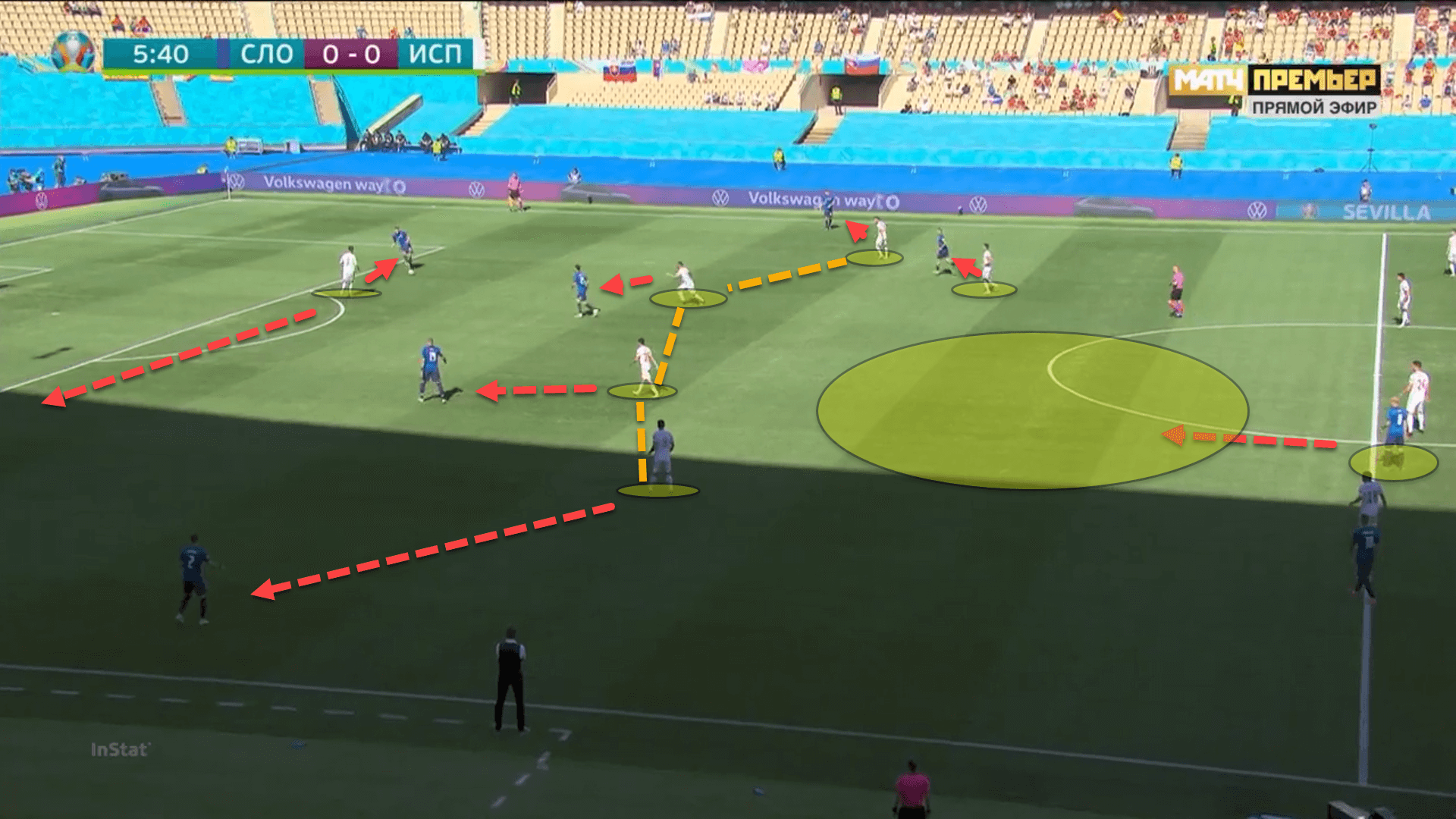
In this image, Spain’s 4-1-4-1 man-oriented high press can be seen. Spain’s system matched up perfectly against Slovakia’s 4-2-3-1. In Spain’s high press though, the three central midfielders are extremely man-oriented and follow their men into deep areas of the pitch, including Busquets.
Here, Hamšík has dropped out to the right and Busquets has followed him deep whilst Pedri and Koke are staying tight to Kucka and Hromada. There is a massive gulf of space left in behind the midfield line though due to Busquets vacating the area. Since their build-up play was failing, Tarkovič could have instructed one of the forwards to try drop into this space and allow the centre-backs to go long.
However, instead, they failed to adapt to the game around them and their build-up play eventually caused them to concede the opening goal of the game, albeit the move ended in a howler from Dúbravka.
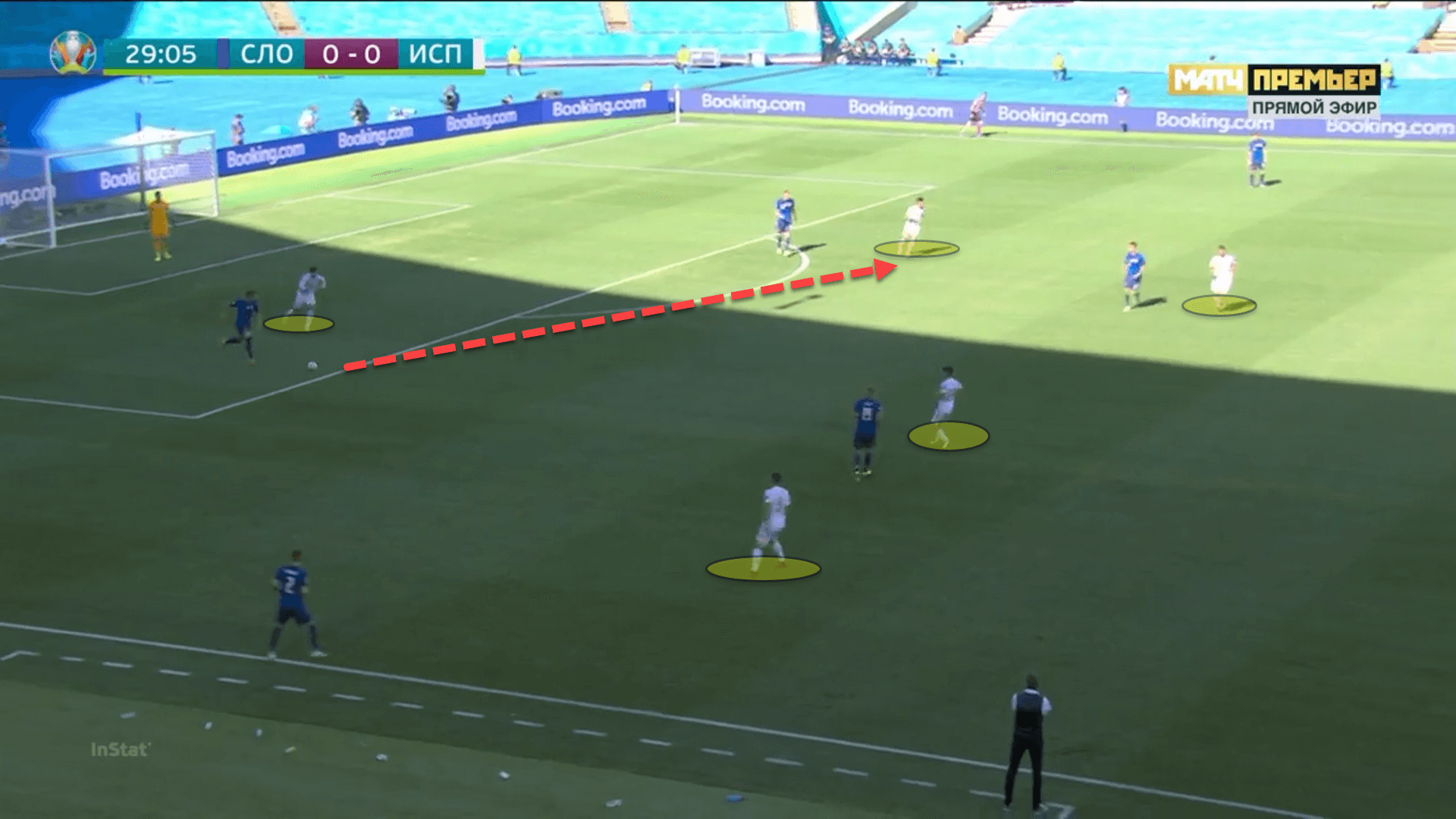
Conclusion
Spain finished second in the group ultimately, which could be deemed a failure, but the fans can be happy with their draw against Croatia in the Round of 16. Zlatko Dalic’s side struggled in the group and looked a shadow of their World Cup team from 2018 so Spain will have a great chance of progressing to the quarters.
The issue with their second-place finish is that they will meet the winners of the game between France and Switzerland. Logistics and probability would tell you that Spain will meet France in the quarters which is an incredibly difficult match for Enrique’s draw.
For Slovakia on the other hand, their tournament has come to a close. Tarkovič’s men came out with a roar after beating Poland 2-1 and now go home with a whimper. Their failure to contain Spain in any phase of the game and lack of adaptation cost them greatly, suffering the heaviest defeat seen so far in the tournament.






Comments